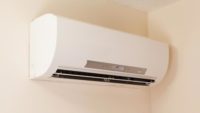Looking back to 1991 when we first started searching for home designs, there was a radiant heating revival underway in the USA. I was relatively familiar with radiant heating because my company, which I had purchased from the third-generation owners, had installed a number of hydronic radiant heating systems with adaptive hydraulic outdoor reset controls in the 1940s. The systems were conceived by Jack Spotz, a well-known local architect and a family friend. His drawings depict black iron piping embedded in concrete that were works of art, and the installer had to precisely follow his detailed layout.
Having worked in many of those homes while maintaining the owners’ hydronic systems, I was more than a little familiar with how comfortable they felt. Most were in-floor systems, but I had to chuckle when one homeowner who had recently purchased his home called in a panic to say he didn’t think his heating system was going to work: “I can’t find any baseboard or radiators.” Upon arrival, I turned up the home’s thermostat and within minutes could feel the radiant rays emanating from his ceilings.
We built our forever home in 1993 and incorporated 10 zones of hydronic radiant heating. That led to a radiant revival for our business, with hundreds of miles of radiant PEX installed for our customers. No fear, right? Well, no, and here’s why: Training via numerous manufacturers and Siggy (PM Engineer columnist John Siegenthaler) via RPA (Radiant Professionals Alliance) gave me a rock-solid base from which I was able to offer design-build radiant comfort systems. Round that out with Robert Bean (healthyheating.com), who took great delight in stuffing my cranium with educational knowledge about, as Paul Harvey would say, the rest of the story regarding comfort environment condition.
A new revolution
And now comes radiant cooling, which reminds me of where we were some 30 years ago with radiant heating in the USA. Personally, I think we are poised for a radiant cooling revolution with tremendous growth potential. One “problem” we have experienced with radiant heating has been solar heat gain where high mass floors absorb the sun’s energy only to release it into the living space, resulting in overheating. Radiant cooling offers a solution, and with geothermal systems, that energy can be transferred to the earth heat exchanger.
All about humidity
However, before we jump in with both feet, this ain’t your father’s radiant system! That said, it’s not all that complicated either — it’s applied science, not rocket science. The first component that must be considered is humidity control. Nothing new there as we’ve been doing that all along with either ducted HVAC systems or mini-splits, right?
In ducted or mini-split systems, we’re sizing ductwork for the higher cfm flow for AC or mini-splits for the full load. Radiant cooling can cut costs by sizing for the reduced latent load to accommodate the difference needed to meet peak demand. It must, however, be able to maintain humidity below 50% RH (relative humidity), which will keep the radiant cooling panel (be it ceiling, floor or wall) above the dew point (more on dew points to follow).
Our bodies are radiators. We generate heat energy at varying levels based upon activities, but for residential AC, we generally figure 350 Btu/h per body present in our Manual-J calculations. In radiant heating calculations, we take into account the MRT (mean radiant temperature) of the combined surfaces in a given room. If we supply sufficient radiant heat to the room that is higher than the Btu we are producing, we feel warm. Too high MRT equals uncomfortably warm. Our skin surface temperature is 84° F, on average, which is why we design for a maximum FST (floor surface temperature) of 84° F. Go above that, and feet start to sweat. Our bodies give off the heat we generate by respiration; radiation; conduction and convection.
The good news for radiant cooling is radiation accounts for 50% of the heat energy we give off. Sensible heat, and heat always moves toward cold, is why we experience what’s called 70-degrees-cold (Fahrenheit) when walking down the frozen foods aisle in the grocery store. Our body’s sensible heat is rushing off to the walls of cold glass. You can experience the same phenomenon in winter if standing or seated close to a glass window.
If we maintain humidity levels at 50% or lower and ensure the floor, wall and ceiling surface temperature will be 66° F or higher, then there will be no worries about falling below the dew point. No wet surfaces — unlike that cool drink filled with ice that absorbs latent heat and condenses because its surface is below the dew point, leaving a moisture ring in that nice wooden table — that equals the dog house for you! Much like walking into a basement during the dog days of summer with its MRT below your 84° skin surface temperature, you will feel cool. After all, 84 – 66 = an 18° F ΔT.
Energy sources
The advent of air-to-water high-efficiency inverter heat pumps along with geothermal systems gives you a wide range of radiant heating and cooling energy sources. Our first radiant cooling system incorporated an air-to-water inverter heat pump, Warmboard floor radiant panel and two hydronic air handlers for extracting the latent moisture during summer cooling season and rapid recovery in heating season, which enabled the owners to incorporate programmable control strategies to further conserve energy. The best design strategy is designing for ultra-low radiant heating water temperatures, which will automatically ensure your radiant cooling panel(s) will offer peak efficiency and conserve energy.
From Robert Bean’s website, we find the following Btu outputs for radiant heating/cooling systems. Radiant sensible cooling factors in a 76° room at 50% (or less) RH: Floors 12 Btu/h psf (per square foot); walls 14 Btu/h psf; and ceilings 19 Btu/h psf.
Radiant heating in a 70° room with 84° FST: Floors 28 Btu/h; walls 20 Btu/h; and ceilings 15 Btu/h. Note: maximum surface temperatures for walls are 120° and 95° for ceilings.
As with radiant heating systems, adding up the Btu/h per square foot and comparing that to the cooling load, will allow you to better determine the reduced AC tonnage for the air handler or mini-splits and proper duct sizing. Fortunately there are now plug-and-play control strategies for radiant heating and cooling systems with the following examples representing a few:
-
www.tekmarcontrols.com/products/alternative-energy/406.html;
-
www.uponor.com/int/products/room-temperature-controls/uponor-smatrix; and
- www.radiantcooling.com/download/brochures/mControls_Brochure_Printable.pdf.
So we now have the means, the parts and pieces, all we’re missing is the training necessary to move forward with confidence and an assurance our customers’ homes and businesses are not a SWAG at providing healthy comfort. Fortunately we have excellent resources available:
- Our own in-house expert: www.pmmag.com/articles/95765-the-basics-of-radiant-ceiling-cooling; and
- ASHRAE courses starting with the basics: www.ashrae.org/professional-development/all-instructor-led-training/instructor-led-training-seminar-and-short-courses/basics-of-panel-heating-cooling
There will never be a better time to get in on the ground floor for designing and installing radiant cooling systems.
You can reach industry icon Dave Yates at dyates@fwbehler.com.
Note: The views expressed here are strictly those of the author and do not necessarily represent PM Engineer or BNP Media.




